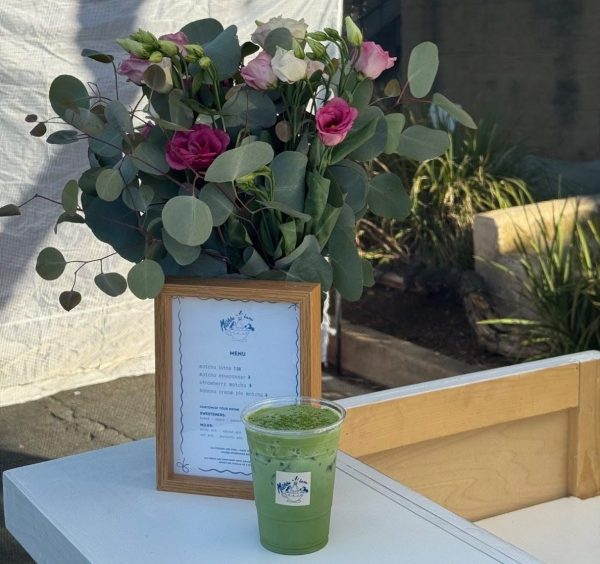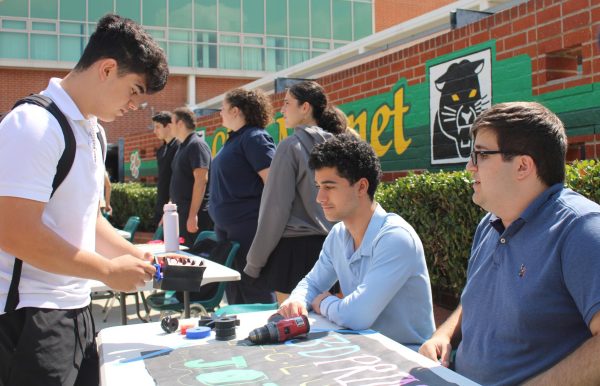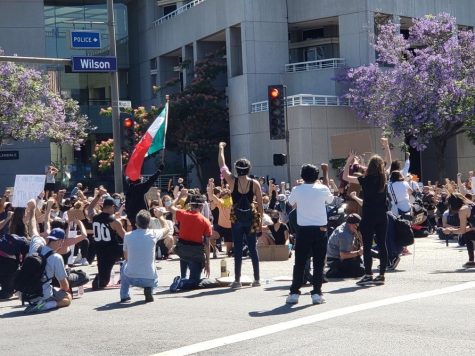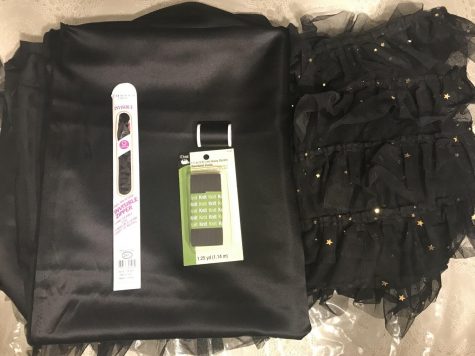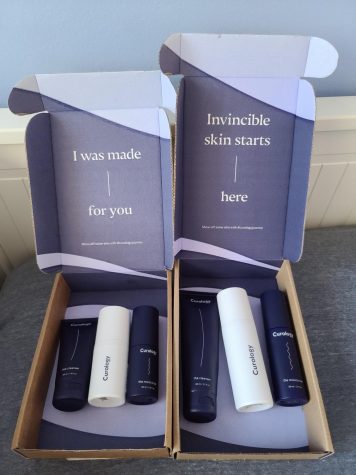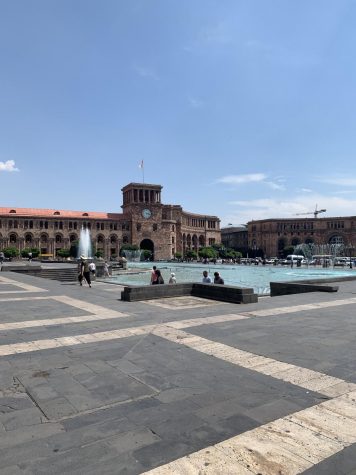Inktober paints the world
Melanie concentrates as she puts the finishing touches with her alcohol ink.
The ink left nothing untouched, staining and smudging the table, scratch paper, and even my hand. A mess of paper and ink surrounded me, but only one area was left organized. My sketchbook that I filled with meticulous work and effort for the past 30 days stared back at me. Thirty days of work filled the sketchbook to the brim, both the good and bad. I finally finished the final piece— I had completed Inktober.
Inktober is a social media phenomenon that has taken the art world by storm. For every day in October, participants make one drawing that incorporates ink in its media. The theme or subject of the drawing is completely up to the artist, as long as the piece has ink — colored or black — then it fits right into Inktober. Then, once the artists are satisfied with the work for the day, they can post on social media.

Likewise, they can look at other people’s Inktober pieces of the day just by searching the hashtag. Finding the millions of other posts under the tag really makes one realize just how widespread the challenge is.
On the official Inktober website, Utah illustrator Jake Parker explains how he created the challenge in 2009 to improve his inking skills and drawing habits. Parker shared that only ten people participated the first year, but Inktober turned viral with the help of #Inktober. According to Paste, compared to the measly ten participants in 2009, over 46,000 Instagram posts were under the hashtag in 2013 and at least 186,000 in 2014. The numbers kept growing, reaching into the millions by 2015.
I began the month with the supplies any challenger needs: lots of ink. Drawing and inking for 31 days straight will wring any pen dry. Some people settle for ordinary office pens and still create works of art; others splurge on their supplies and use fountain pens and a variety of colored inks. My were black Sakura Pigma Micron pens.
The pens are meant for outlining and light inking, which is what most my drawings are.
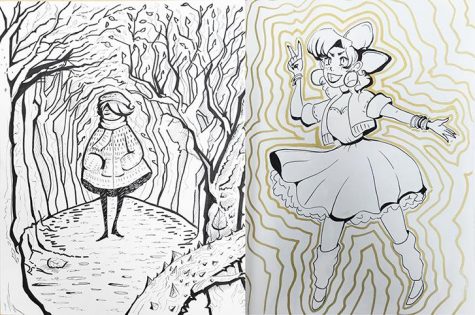
Mary utilizes texture and patterns on the left and uses expressive character design on the right.
Mary Vardanyan, a Clark junior who also participated in Inktober, used a mix of ink pens, markers and watercolor. Another junior, Melanie Mesropian, used alcohol ink and sharpies. When asked about her experience with Inktober, Mesropian confessed that Inktober was difficult. “It’s been difficult since I’m trying something new,” Mesropian said. “I haven’t really used alcohol ink before and now my drawings are solely based on alcohol ink. I’ve also been using sharpies and they’re both just different for me.”
Days one through six were easy to draw, as most of my pieces consisted of fan art or simple original pieces exploring inking styles. I admittedly favored one series, Love Live!, over the others, but I was grateful for the inspiration. In some drawings I practiced perspective and colors and others I tested styles of shading and texture. Going from a pencil sketch to simple lining and finally to detailed inking was a fulfilling experience.
I would finish inking the drawing for the day and quickly sketch an outline for the following day in pencil. This schedule was helpful and time efficient since the most time consuming part of drawing is figuring out what to draw and how to start it. However, I could only do this due to the leniency of my school schedule and sparse amount of homework at that time. So when work started picking up at school two weeks into October, it became a struggle to finish one day’s drawing, not to mention preparing for the following days.

Melanie incorporated beautiful colors in some of her Inktober pieces.
The output and quality of my art in the middle of the month took a drop as I began studying for tests. It was at this time that Inktober became a real challenge. Not only do you have to plan and compose a drawing, but you have to manage your schedule and make time to do so. Unlike professional artists or people with flexible jobs, students are hard-pressed with their school schedule and extracurricular activities.
If you’ve ever asked about how to improve your drawings, then you’ve most likely heard “draw everyday” as an answer. It’s a mantra in the art world, and something that is adhered to by many professional artists. Just drawing every day of October is a challenge, so admittedly drawing for all 365 days of the year is an intimidating thought. John Over, an animation teacher at Clark, agrees that it’s challenging to find time to draw every day. “When all the students leave, I’ll think I never get to draw something I want to draw,” Over said. “I’m always just fixing some little thing in class.”
If even an animation teacher finds it difficult to devote time every day to art, the sheer number of other responsibilities for students is a looming concern for all aspiring student artists. Drawings can take a long time to complete, especially when it’s a piece you’re really invested in. “If I’m actually working on a piece that requires detail, I take my time, about an hour or more,” Vardanyan said.

However, drawing daily is not an impossible task. “I think you shouldn’t just need to draw something every day,” Over said. “I think you should draw something different every day. You should challenge yourself with something different.” Drawing the same thing will get boring, so trying something new is a good way to enjoy yourself as well as improve your skills. Over said that getting comfortable with drawing the same thing is unproductive and will only “maroon you on that island.” That’s why Inktober is such a remarkable event that showcases the variations in everyone’s art.
Making an inked piece you’re satisfied with to post on social media is difficult. Unless you’re an experienced artist or just a talented person, Inktober is a challenging month that saps all your creativity — art block is your greatest enemy. To overcome art block, Over recommends seeing other works of art to inspire you, and then find a way to interpret them in your own way. “Go see films, go to museums, get outside of yourself and you’ll be inspired in other ways,” Over said.
As daunting as it may be, Inktober can actually be a fulfilling challenge. It pushes you to practice your drawing every day, further refining your skills. The original purpose of the challenge was to help improve an artist’s inking skills, but it also trains other art skills as well. Drawing anatomy, backgrounds, or other subjects for 31 days straight inevitably builds an artistic foundation. “I think I’ve gotten better at understanding different styles and being able to do more precise work that needs more patience,” Vardanyan said. She was very proud of all her 31 drawings, but most of all, she was proud of her improvement.
In retrospect, millions of people share Vardanyan’s sentiment. Millions of people were able to participate in the Inktober challenge and see each other’s progress. A small activity that started between friends grew to be something so big. Over said it is amazing to see the impact of this global artistic movement. He contemplated on what made the challenge so popular, crediting the Internet for its vast network and reach. “But it has to connect with people in a way that lends them a unique challenge— you have to give somebody a unique challenge; that will start a movement,” Over said.
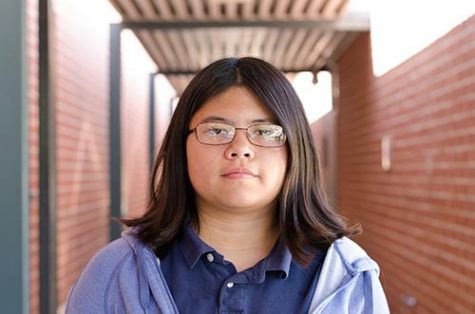
Hobbies/Interests: Writing and drawing stuff
Favorite Movie: Beauty and the Bestie
Favorite Food: Fries
Plans for the future: I plan to work in the...








